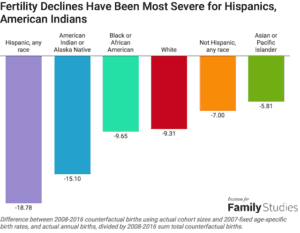Baby Bust: Fertility Is Declining the Most Among Minority Women
Lyman Stone, IFS, May 16, 2018
The United States just hit a 40-year low in its fertility rate, according to numbers just released by the Centers for Disease Control and Prevention. The 2017 provisional estimate of fertility for the entire U.S. indicates about 3.85 million births in 2017 and a total fertility rate of about 1.76 births per women. These are low numbers: births were as high as 4.31 million in 2007, and the total fertility rate was 2.08 kids back then. The United States has experienced a remarkable slump in fertility over the last several years, as I’ve explained elsewhere.
{snip}
At least through 2016, this trend appeared to be mostly driven by changes in marital status. Births to never-married women are down more than births to ever-married women: age-adjusted marital fertility is down 14% since 2007, while age-adjusted never-married fertility is down 21%, as of 2016. Preliminary data from several states suggest these trends are likely to continue in 2017.
{snip}
At the end of the day, though, racists on the right are wrong (and comparatively few in number), but so are the progressives who assume that calls for more babies are racially driven.
That’s because the decline in fertility has been far greater among minorities than among non-Hispanic whites. If we take age-specific birth rates from the peak-fertility year of 2007 and apply them to each age cohort in 2008-2016, the most recent complete data, we can create a counterfactual scenario of how many babies would have been born if age-adjusted fertility rates had not fallen after 2007. From 2008 to 2016, the deficit turns out to be between 4.1 and 4.6 million missing babies: basically, an entire year’s worth or more of childbearing vanished.
The deficit varies across racial and ethnic groups. American Indians and Alaska Natives have it worst among racial groups, having lost a whopping 15% of expected fertility from 2008 to 2016, or about 83,000 births, with total fertility rates falling from 1.62 births per woman to a shockingly low 1.23. It’s unclear exactly why Native American fertility has fallen so quickly and why it is so low, but they are indisputably the hardest-hit race in the fertility declines of the last 10 years.
Then come African Americans, who are missing 9.6% of expected births, or about 700,000 births, which is only slightly more severe than whites, who are missing 9.3%, or about 3.2 million births. Black fertility declined from 2.15 births per woman to 1.89, while white fertility fell from 2.14 to 1.82. Asians experienced a less severe decline, but their fertility was somewhat lower to start with.
{snip}
But the “white” fertility figure is a bit misleading, as it includes most Hispanics, who have historically had much higher birth rates than non-Hispanic whites. Looking at all Hispanics together, these women are missing nearly 19% of the babies that would have been born from 2008-2016, or about 2.2 million births, as their age-adjusted fertility rates have fallen from 2.85 births per woman to just 2.1, and continue to decline. Meanwhile, non-Hispanic fertility has only declined from 1.95 births per woman to 1.72, yielding about 2.3 million missing births. Solidly half of the missing kids over the last decade would have been born to Hispanic mothers, despite the fact that Hispanics only make up about a quarter of fertility-age women.
Thus, in racial or ethnic terms, America’s “Baby Bust” [has] hammered Native Americans and Hispanics particularly hard, and hit even African Americans harder than whites generally, and certainly harder than non-Hispanic whites. The call to boost fertility is far from being a call for whites to keep up with minority fertility; rather, it’s an exhortation that we need to be listening to the fertility desires of women of racial and ethnic minorities, who are experiencing precipitous declines in fertility, largely unnoticed by the white-dominated world of mommy-blogs and late-in-life fertility treatments. Any serious pro-natal policy in America worth its salt would primarily result in birth gains among minority mothers, not white ones. Accelerating the national birth rate would also accelerate the pace at which the non-Hispanic white population share declines.
{snip}
Other factors are at work, too. Fertility has fallen somewhat more for less educated than for more educated women. Age-adjusted fertility has fallen 15% for women with a bachelor’s degree or less, versus just 7% for women with graduate degrees. On the whole, births to women with no bachelor’s have totaled 12% below what would be expected if 2007 fertility rates had continued, yielding 3.1 million missing births, while births to women with a bachelor’s degree are down 10% for 1.1 million missing births, and births to women with a graduate degree are down just 7%, or 300,000.
{snip}
Fertility declines are most strongly associated with factors that are race- or region-specific, not broadly class-specific, as different economic classes appear to have quite similar trends. {snip}

















